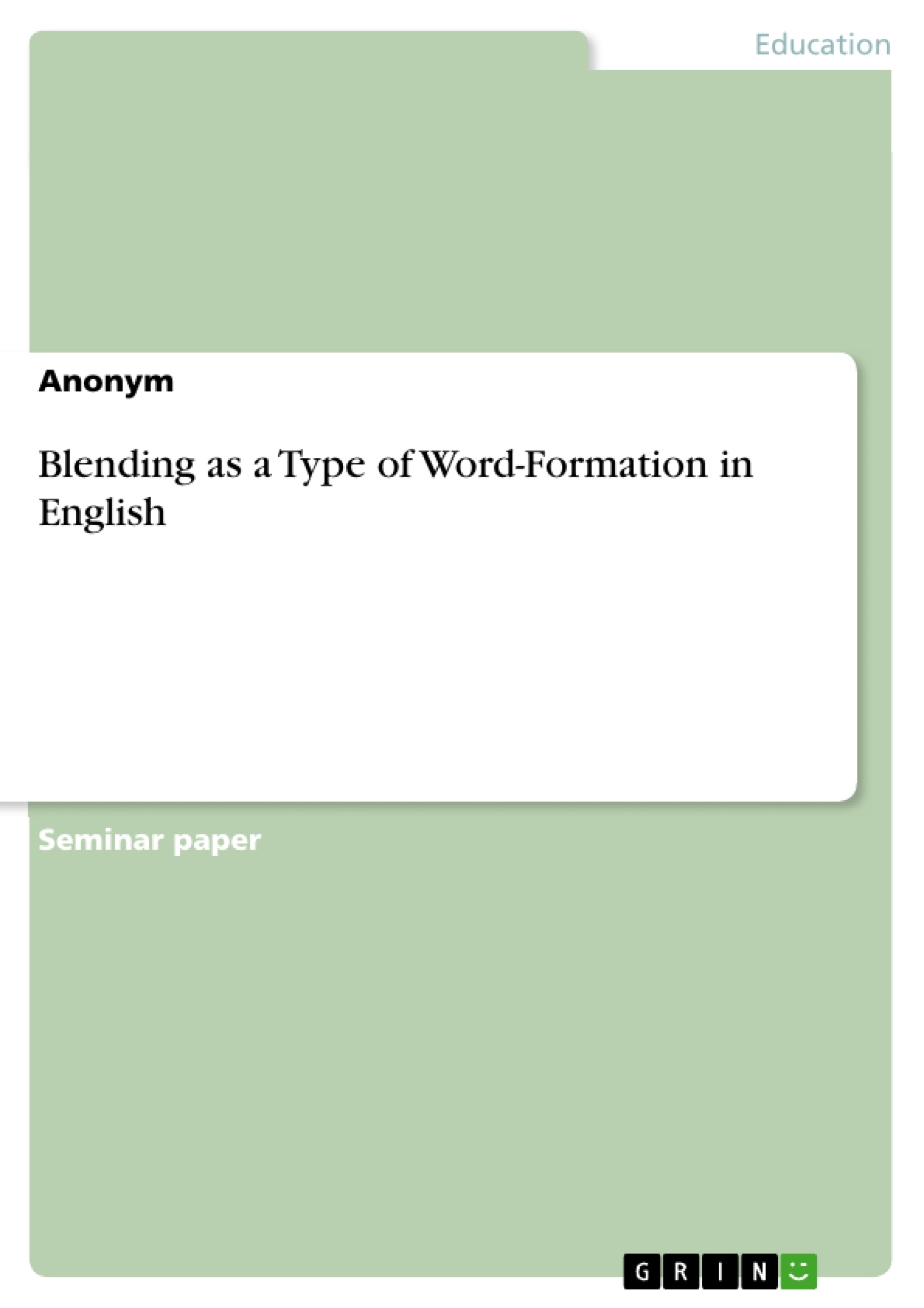As a part of this term paper I will show how the blends are classified into modified
and meaningful blends and how they are categorized, including the categorization of their
source words.
I am going to answer the question how blends are structured and what kind of rules
there are for their formation. The term paper will answer all these questions by analyzing
blends and their source words and this will show that blending is a word – formation process.
Table of Contents
- 1. Introduction
- 2. Classification of Blends
- 2.1 Modified Blends
- 2.2 Meaningful Blends
- 3. Categories of Blends and their source words
- 4. Structure of Blending
- 4.1 First Rule for Blending-Formation
- 4.2 Second Rule for Blending-Formation
- 4.3 Third Rule for Blending-Formation
- 5. Conclusion
Objectives and Key Themes
This term paper aims to explore blending as a word-formation process in English. It investigates the classification, categorization, and structural rules governing blend creation. The analysis focuses on how blends are formed from source words and the resulting semantic relationships.
- Classification of blends (modified vs. meaningful)
- Categorization of blends and their source words
- Structural rules of blend formation
- Blending as a word-formation process
- Examples of blends from literature and everyday language
Chapter Summaries
1. Introduction: This introductory chapter establishes the concept of blending as a word-formation process in English, citing examples from literature such as Lewis Carroll's "Alice's Adventures in Wonderland" (slithy, mimsy) and works by Robert Greene and Samuel Purchas. It defines blending as a process of combining parts of two or more words to create a new lexeme, highlighting its creativity and common usage in modern English. The chapter sets the stage for a deeper examination of blend classification, structure, and rules of formation.
2. Classification of Blends: This chapter delves into the classification of blends, dividing them into two main categories: modified and meaningful blends. Modified blends, exemplified by words like "breathalyzer" and "motel," are characterized by one element modifying the meaning of the other. Meaningful blends, such as "brunch" and "smog," demonstrate a combination of properties from both source words, creating a new meaning that reflects both origins. This section provides numerous examples to illustrate the distinct characteristics of each blend type.
3. Categories of Blends and their source words: This chapter examines the semantic relationship between source words and resulting blends. While many blends share the same semantic category as their source words (e.g., noun + noun = noun), the chapter acknowledges exceptions to this rule. The analysis of examples demonstrates the commonality of noun blends but also highlights instances where the resulting blend's category differs from its source words. This exploration emphasizes the diverse ways blends can integrate semantic elements from their origins.
Keywords
Blending, word-formation, English morphology, modified blends, meaningful blends, source words, semantic categories, structural rules, lexeme.
Frequently Asked Questions: A Comprehensive Language Preview on Blending in English
What is the main topic of this language preview?
This preview comprehensively explores the word-formation process of blending in English. It analyzes the classification, categorization, structural rules, and semantic relationships involved in blend creation.
What are the key themes addressed in this preview?
The key themes include the classification of blends (modified vs. meaningful), the categorization of blends and their source words, the structural rules governing blend formation, and the overall role of blending as a word-formation process in English. The preview also provides numerous examples from literature and everyday language.
How are blends classified in this preview?
Blends are classified into two main categories: modified blends and meaningful blends. Modified blends involve one element modifying the meaning of another (e.g., "breathalyzer," "motel"). Meaningful blends combine properties from both source words to create a new meaning reflecting both origins (e.g., "brunch," "smog").
What are the structural rules for blend formation discussed in the preview?
The preview details three rules for blending formation, although the specifics of these rules are not provided in the summary. The existence of these rules highlights the systematic nature of blend creation.
What is the relationship between source words and resulting blends in terms of semantic categories?
While many blends share the same semantic category as their source words (e.g., noun + noun = noun), the preview acknowledges exceptions. The analysis demonstrates the commonality of noun blends but also highlights instances where the resulting blend's category differs from its source words, showcasing the diverse semantic integration in blend formation.
What examples of blends are provided?
The preview includes examples such as "slithy" and "mimsy" from Lewis Carroll's "Alice's Adventures in Wonderland," "breathalyzer," "motel," "brunch," and "smog." It also mentions examples from the works of Robert Greene and Samuel Purchas, though the specific blends aren't named.
What is the overall purpose of this language preview?
The preview aims to provide a structured and professional analysis of blending as a word-formation process, offering a clear understanding of its classification, structure, and semantic implications. It serves as a concise overview for academic use.
What are the key words associated with this topic?
Key words include blending, word-formation, English morphology, modified blends, meaningful blends, source words, semantic categories, structural rules, and lexeme.
What chapters are included in this language preview?
The preview includes chapters on Introduction, Classification of Blends (including Modified and Meaningful Blends), Categories of Blends and their source words, Structure of Blending (with three rules), and Conclusion.
- Citar trabajo
- Anonym (Autor), 2013, Blending as a Type of Word-Formation in English, Múnich, GRIN Verlag, https://www.grin.com/document/232366



